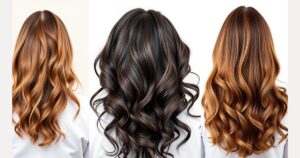Research shows that about 50 million men in the U.S. suffer from male pattern baldness. Testosterone’s role in hair loss is complex. It’s important to understand how hormones affect hair health.
Does testosterone cause hair loss? Testosterone and hair loss are linked through dihydrotestosterone (DHT). This hormone is much stronger than regular testosterone and affects hair follicles. Not everyone with high testosterone will lose hair, but genetics play a big part.
Does testosterone cause hair loss? The 2025 study found that testosterone’s effect on hair is not straightforward. Some people are more likely to lose hair because of their genes. The AR gene is key in how hair follicles react to hormones, making each person’s experience unique.
Studies now show that both too much and too little testosterone can lead to hair loss. When testosterone turns into DHT, it starts a process that shrinks hair follicles. This disrupts normal hair growth cycles.
Understanding the Testosterone-Hair Loss Connection
The link between testosterone and hair loss is complex. It involves many biological processes that affect hair follicle health and growth. Hormonal hair loss comes from the interaction of genetics and hormonal changes.
Testosterone comes in two main forms in our bodies. Each form has a different role in our health:
Types of Testosterone in the Body
- Free Testosterone: This is the active form of testosterone that our bodies use.
- Bound Testosterone: This form is attached to proteins and is less active.
Role of DHT in Hair Loss
Dihydrotestosterone (DHT) is a key player in hair loss. When testosterone turns into DHT, it can change how hair follicles work.
“DHT causes hair follicles to shrink, leading to thinner hair and eventual baldness.” – Dermatological Research Institute
Genetic Predisposition Factors
Genetics play a big role in testosterone-related hair loss. People don’t all lose hair the same way. This is because genetics affect how sensitive we are to DHT.
- Some people are more sensitive to DHT in their hair follicles.
- Genetic markers can show how fast hair loss will progress.
- Family history can hint at what hair loss patterns you might have.
Knowing about these connections helps us understand our hair loss risks. It also helps us find ways to treat it.
The Science Behind Does Testosterone Cause Hair Loss
To understand how testosterone affects hair loss, we must look at the biological processes involved. At the heart of this is dihydrotestosterone (DHT), a strong form of testosterone. It’s key in changing hair follicles.
DHT starts a process called follicular miniaturization. When hair follicles are exposed to this hormone, they shrink. This shrinkage causes:
- Thinner hair strands
- Reduced hair production
- Gradual scalp coverage reduction
Genetics play a big role in how much DHT affects hair loss. Not all men lose hair at the same rate. This is because genetics decide how sensitive hair follicles are to DHT.
Studies show that not all testosterone turns into DHT. Only a small part of it does, which can lead to hair loss. This is why some men with high testosterone levels keep their hair.
Interestingly, genetic studies suggest that male pattern baldness might be more closely linked to pigmentation pathways than direct testosterone impacts.
The scientific world is working hard to understand the links between hormones, genetics, and hair loss. This research gives hope to those dealing with DHT-related hair thinning.
How Testosterone Affects Hair Follicles
It’s linked to hair thinning through a complex process. This process changes how hair follicles function.
The way testosterone and hair follicles interact is complex. Scientists have found important details about how hormonal shifts cause hair loss.
Hair Growth Cycle Transformations
DHT, a strong androgen, greatly affects the hair growth cycle. Important findings include:
- DHT is five times more powerful than testosterone in binding to hair follicle receptors
- Shortens the anagen (growth) phase of hair development
- Prolongs the telogen (resting) phase
Follicle Miniaturization Process
The miniaturization of hair follicles is a key step in hair loss. Genetic predisposition plays a big role in who gets this.
“Follicle miniaturization is not just a symptom, but a complex hormonal response.”
Impact on Hair Production
When testosterone and DHT meet follicles, hair production changes a lot:
- Hair strands become progressively thinner
- Growth rates diminish
- Overall hair density decreases
Knowing how these hormones work together is key to understanding and maybe even stopping testosterone-related hair loss.
High vs Low Testosterone Levels and Hair Health

Understanding how testosterone affects hair loss is complex. It involves how hormone levels impact hair health. Hair follicle sensitivity is key in determining testosterone’s effects on hair growth and loss.
Testosterone’s impact on hair health changes with hormone levels:
- High testosterone levels can speed up male pattern baldness by increasing DHT production.
- Low testosterone levels may lead to hair thinning and slower growth.
- Genetic predisposition affects how sensitive hair follicles are to testosterone.
Studies show that about 2-5% of testosterone turns into dihydrotestosterone (DHT), a hormone that causes hair loss. It’s not just the total testosterone level that matters. It’s how sensitive the hair follicles are to DHT that determines hair loss.
Important facts about testosterone and hair loss include:
- DHT is made from testosterone through the enzyme 5α-reductase.
- Genetics decide how vulnerable hair follicles are to DHT.
- Keeping hormone levels balanced is important for hair health.
Treatments like finasteride can help manage testosterone-related hair loss by stopping DHT production. With an 83% success rate in preventing hair loss, these treatments offer hope for those facing hormone-related hair issues.
The Role of DHT in Male Pattern Baldness
Male pattern baldness is a complex genetic condition linked to dihydrotestosterone (DHT). DHT is a powerful androgen that plays a key role in hair loss. Knowing how DHT affects hair follicles can help men manage their hair health better.
DHT forms through a specific biological process that impacts hair growth. About 10% of testosterone is turned into DHT daily by the enzyme 5-alpha reductase. This happens in hair follicles, skin, and the prostate.
DHT Formation Process
- Testosterone is transformed by 5-alpha reductase enzyme
- Conversion occurs in multiple body tissues
- DHT is a more potent androgen compared to testosterone
Sensitivity of Hair Follicles
Not all men lose hair the same way because of genetic differences. The sensitivity of hair follicles to DHT varies. Some people’s follicles are more affected by DHT’s shrinking effects.
Areas Most Affected by DHT
| Scalp Region | DHT Impact |
|---|---|
| Crown | High susceptibility to follicle miniaturization |
| Temples | Significant hair loss |
| Frontal Hairline | Progressive recession common |
DHT causes hair follicles to shrink, dramatically shortening the hair growth cycle and leading to progressive hair thinning. Understanding these mechanisms can help men explore treatment options and management strategies for male pattern baldness.
“Hair loss is not just about aging, but about how your body processes hormones like DHT.” – Dermatology Research Institute
Testosterone-Related Hair Loss Patterns

Male pattern baldness shows a clear pattern that links testosterone to hair loss. This type of hair loss changes a person’s look in noticeable ways.
The typical pattern of testosterone-induced alopecia includes two main areas of hair loss:
- Frontal Hairline Recession: Creates an distinctive M-shaped pattern
- Vertex Thinning: Gradual balding at the crown of the head
Studies show that male androgenetic alopecia affects 30-50% of men by age 50. The hair loss follows the Norwood-Hamilton scale, showing how severe it is. Genetics play a big role in who gets this hair loss.
Dihydrotestosterone (DHT) is the main cause of this hair loss. It’s a strong form of testosterone that harms hair follicles. This leads to smaller hair follicles and eventually, hair loss. Some people might grow more body hair but lose scalp hair.
The androgen receptor gene, passed down from mom, affects hair loss. This gene decides how much hair loss a man will have. It’s why some men lose hair faster than others, even with the same testosterone levels.
Latest Medical Treatments and Solutions
Dealing with hair loss from testosterone replacement therapy needs a full plan. People losing hair from testosterone supplements can try different medical ways to stop hair loss and help hair grow.
Today’s science has many good ways to fight hormone-related hair loss:
Prescription Medications
Medicines can help grow hair back:
- Finasteride (Propecia): Blocks testosterone turning into DHT
- Dutasteride: Stops more enzymes from turning into DHT
- 5-alpha reductase inhibitors: Lower DHT levels
Topical Treatments
Topical treatments work right on the scalp:
- Minoxidil: Boosts blood flow and makes follicles work better
- Ketoconazole shampoo: Cuts down inflammation
- Rosemary oil: A natural choice that works like minoxidil
Surgical Options
Surgery offers lasting fixes:
| Procedure | Description | Success Rate |
|---|---|---|
| Follicular Unit Excision (FUE) | Transplants single follicles | 85-95% |
| Follicular Unit Transplantation (FUT) | Uses a strip to move follicles | 80-90% |
It’s key to talk to a doctor before starting any hair loss treatment.
Studies show 63% of people with thinning hair see good results with the right treatments.
Natural Remedies and Prevention Strategies
Learning about testosterone and hair loss can lead to natural ways to prevent it. While medical treatments are important, natural methods can also help keep your hair healthy. This can reduce concerns about testosterone and hair loss.
Some foods and nutrients might help manage hair loss caused by testosterone:
- Green tea has EGCG, which protects hair follicles with its anti-inflammatory effects
- Onions, full of quercetin, can stop DHT production
- Turmeric, with curcumin, may lower DHT levels
- Pumpkin seeds offer zinc and magnesium to help hair grow
Here are some key foods to eat to fight testosterone-related hair loss:
- Eat foods high in protein
- Boost omega-3 fatty acids in your diet
- Add antioxidant-rich veggies to your meals
- Make sure you get enough vitamins
Changing your lifestyle can also help your hair:
- Try stress-reducing activities
- Do scalp massages regularly
- Use essential oils like rosemary and peppermint
- Keep a regular sleep schedule
While these natural methods can’t stop testosterone-induced hair loss completely, they can help keep your hair healthy. This might slow down hair loss.
| Natural Remedy | Potential Hair Loss Prevention Benefits |
|---|---|
| Saw Palmetto | Natural DHT blocker |
| Zinc Supplements | Supports hair follicle health |
| Biotin | Promotes hair strength |
| Vitamin D | Supports hair growth cycles |
Note: Individual results may vary, and consulting a healthcare professional is recommended for personalized advice on managing testosterone and hair loss.
The Link Between Age, Hormones, and Hair Loss
Aging changes our body’s hormones a lot. It affects how our hair grows and falls out. Knowing how hormones, testosterone, and hair health connect is key as we get older.
Hormonal hair loss is complex. As men get older, their testosterone levels drop. This can change how hair grows a lot.
Age-Related Hormonal Transformations
Testosterone’s impact on hair grows stronger with age. Important hormonal changes include:
- Testosterone peaks around age 20 and then goes down
- Dihydrotestosterone (DHT) production goes up
- Genetic factors make hair follicles more sensitive
Impact on Hair Growth Cycles
Aging brings senescent alopecia, a hair loss type different from androgenetic alopecia. This involves:
- Less ability to regenerate cells
- More oxidative stress
- Hair follicles less responsive to hormones
About 50 million men and 30 million women have androgenic alopecia. The risk goes up with age and genetic factors.
Managing Testosterone-Induced Hair Loss

Understanding and managing testosterone-induced alopecia needs a full plan. Androgens and hair thinning are closely linked. Genetic factors play a big role in hair loss.
Key strategies for managing testosterone-related hair loss include:
- Early intervention and regular hair health monitoring
- Medical treatments to block DHT production
- Lifestyle modifications to support hair growth
- Stress management techniques
Medical treatments offer promising solutions for testosterone-induced hair loss. Prescription medications like finasteride can block DHT production by up to 90%. This significantly slows hair thinning. Minoxidil treatments improve blood flow to hair follicles, supporting hair growth and preventing further loss.
| Treatment Option | Effectiveness | Mechanism |
|---|---|---|
| Finasteride | 70-90% DHT Reduction | Blocks testosterone conversion |
| Minoxidil | Improves Follicle Health | Increases scalp blood flow |
| Hair Transplants | Permanent Solution | Relocates healthy hair follicles |
Psychological support is key when managing hair loss. Connecting with support groups and staying positive can help. It makes dealing with the emotional side of testosterone-induced alopecia easier.
Lifestyle factors greatly affect hair health. Eating a balanced diet rich in proteins, vitamins, and minerals helps. Stress reduction techniques also play a big role in slowing down hair loss.
Conclusion
The link between testosterone and hair loss is complex. It affects millions of people. Does testosterone cause hair loss? The answer is not simple.
Testosterone and hair loss are tied to genetics, hormones, and how sensitive hair follicles are. This makes hair loss a big issue for many.
New studies are changing how we see hair loss. They show it’s not just about testosterone levels. DHT, a byproduct of testosterone, is key in making hair follicles smaller.
By age 50, over half of men start losing hair. But, treatments like finasteride and minoxidil can help. They work for 76% to 87% of users.
Research is looking into new ways to stop hair loss. It’s found that body sugars might help hair grow. This is because they help blood vessels form around hair follicles.
Genetics and hormones play a big part in hair loss. But, there are many ways to prevent and treat it. This gives people hope for their hair health.
Learning about testosterone and hair loss helps us make better choices. With new medical tech and understanding hormones, fighting hair loss is getting better and more tailored.
FAQ
Q: Does testosterone directly cause hair loss?
A: Testosterone itself doesn’t directly cause hair loss. It’s the conversion to dihydrotestosterone (DHT) that’s key. DHT is linked to hair loss, mainly in male pattern baldness. How much hair loss happens depends on your genetic sensitivity to DHT.
Q: How does DHT contribute to hair loss?
A: DHT causes hair follicles to shrink. This makes hair thinner and shorter. Eventually, these follicles stop producing hair, leading to baldness in those who are genetically prone.
Q: Can both high and low testosterone levels cause hair loss?
A: Yes, both extremes can affect hair health. High testosterone can increase DHT, speeding up baldness. Low testosterone can cause hair to thin and grow less. Keeping hormones balanced is important for healthy hair.
Q: Are there treatments available for testosterone-related hair loss?
A: Many treatments are available. These include medications like finasteride and dutasteride to block DHT. There are also topical treatments, low-level laser therapy, and hair transplantation. A healthcare professional can help choose the best option.
Q: Is testosterone-related hair loss genetic?
A: Yes, genetics play a big role. Some people’s hair follicles are more sensitive to DHT. This makes them more likely to experience baldness.
Q: Can lifestyle changes help prevent testosterone-related hair loss?
A: Lifestyle changes can help. They include managing stress, eating well, exercising, and taking care of your hair. Avoiding harsh treatments can also help.
Q: At what age does testosterone-related hair loss typically begin?
A: Hair loss can start in late teens or early twenties. It becomes more common with age. Hormonal changes and increased DHT sensitivity contribute to hair thinning as we get older.
Q: Do women experience testosterone-related hair loss?
A: Yes, women can experience hormonal hair loss. It’s different from men’s hair loss, often causing overall thinning. Hormonal changes during pregnancy and menopause can influence it.
















[…] Progesterone and weight have a complex relationship. Hormones and body weight are closely linked, with progesterone affecting metabolism. Women who notice sudden weight changes should listen to their body’s hormonal signals. […]